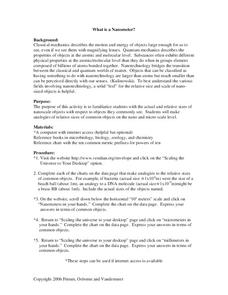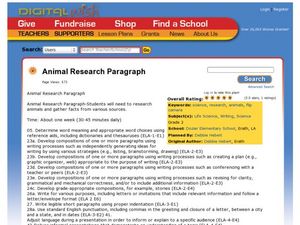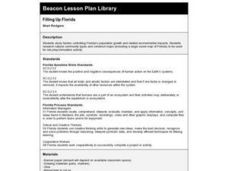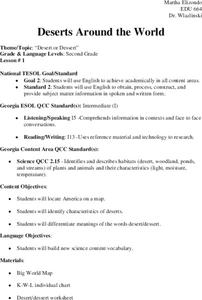Curated OER
Little Red Hen (Makes a Pizza) Lesson Plan
Students create a pizza recipe based on the recipe used in The Little Red Hen (Makes a Pizza) by Philemon Sturges. In this early childhood lesson plan, students read The Little Red Hen (Makes a Pizza) and identify the ingredients needed...
Curated OER
On Market Street
Second graders study basic facts about consumers and consumer goods. The book "On Market Street" is used in this lesson.
Curated OER
Drawing Birds
First graders discuss what they know about birds and share picture books. They read text on the page and discuss the question and draw the flying bird on their paper by having them look at the color drawing of the bird.
Curated OER
Wild Animal Investigation - Habitat Diorama
Students research wild animals in cooperative groups and use their information to construct habitat dioramas. They demonstrate competence in using different information sources, including those of a technical nature, to accomplish...
Curated OER
GeoHunt
Students describe the difference between geological resources and othe natural resources. They list the rocks, minerals, and fossil fuels that are found in Illinois and their uses. They identify ways to conserve natural resources.
Curated OER
Adventures on the Eastern Half of Planet Earth
Seventh graders explore a country in the Eastern hemisphere. They develop a packet that could be used by someone visiting that country during the month of December. Students explore the climate, foods, geography, customs and culture of...
Curated OER
Why Do We Have Thanksgiving?
Pupils investigate the change in the Thanksgiving holiday over time. They research the Native Americans and Pilgrims to find out how their relationship affected the holiday. They create a PowerPoint presentation using digital cameras...
Curated OER
Mini Research Report
Sixth graders select a topic to research. They gather information from at least 3 sources and take notes according to the categories chosen. Students write a rought draft using the notes. They edit, revise and publish the information....
Curated OER
The Grouchy Ladybug
Students learn about sorting and classifying objects by size while reading Eric Carle's "The Grouchy Ladybug". In this sorting and classifying lesson, students first listen to and interact with the story. They then look at cut-outs of...
Curated OER
If It Smells Good, Is Edible, and Attracts Wildlife, Then It's a Practical Garden
Students explore landscape design. In this practical gardening lesson, students design landscape plans that call for shrubs, trees, and plants that can be used for aesthetics, cooking, and wildlife.
Curated OER
Unnatural Selection
Students identify quotation marks and demonstrate the uses of quotation marks. They rewrite sentences without quotation marks and discuss how the meanings can change without the use of quotation marks. In addition, they make their own...
Curated OER
What is a Nanometer?
Students develop a concept of the relative size of objects in the nanoscale. They complete an internet assignment using the website,"Scaling the Universe to Your Desktop". Using analogies to common objects they get an appreciation for...
Curated OER
Adjunct Materials
Students describe and evaluate adjunct educational materials for their usefulness in social studies classrooms. They identify means of randomly pairing students using social studies content and develop social studies-themed unit plans...
Curated OER
Dictionary Details
This clever lesson has students practice finding a variety of types of information in a dictionary by playing a "Dictionary Scavenger Hunt" game. Students must use the guide words at the top of a dictionary page, determine what part of...
Curated OER
Classifying Seashells
Third graders practice classifying seashells. In this seashell classification lesson, 3rd graders listen to a guest speaker talk about collecting seashells. They participate in a discussion on the characteristics by which seashells are...
Curated OER
Petroglyphs: Protecting the Past
Fourth graders investigate the three types of rocks and study about petroglyphs. They explore why petroglyphs were used by the Nez Perce People. Students investigate the properties of the three types of rocks and they discuss cultural...
Curated OER
Civil War Images: It's in the Cards!
Eighth graders review important figures of the Civil War. In this American Civil War instructional activity, 8th graders create flash cards of historical figures of the war and use them to review the war.
Curated OER
Enumeration
In this calculus lesson plan, students review counting using the principles of Enumeration. They use random selections to count and convert word problems and count. There are 21 problems with an answer key.
Curated OER
Animal Research Paragraph
Students investigate animals. In this animal research instructional activity, students choose an animal to research online and record facts from at least 3 types of resources. Students complete a webbing tool, write a paragraph, and use...
Curated OER
Filling Up Florida
Students study factors controlling Florida's population growth and related environmental impacts. They research natural community types and construct maps (including a large-sized map of Florida) to be used for a simulation activity.
Curated OER
Map Scale and the Pioneer Journey
Fourth graders, using a map, ruler and calculator, determine the distance the pioneers traveled from Nauvoo, Ill. to the Salt Lake Valley.
Curated OER
Deserts Around the World
Second graders explore the deserts around the world. They use a map and locate America on the map. Students discuss and identify the characteristics of deserts and differentiate the meanings of the word desert and dessert. Students...
Curated OER
The Plains Native Americans
Students read The Buffalo Woman by Paul Goble and explore several aspects of Plains Indians cultures. They view historical photos of items from Plains cultures, reference maps and complete worksheets in small groups.
Curated OER
The Origins of Man
Students learn about new technologies being used to update what is known about human evolution and migration. They then compare the new theories to the traditional knowledge.























